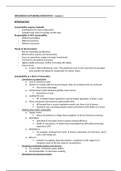ORGANIZING SUSTAINABLE INNOVATION – Lecture 1
INTRODUCTION
Sustainability requires tradeoffs
- Investing less for soon small profits
- Instead invest more for greater profits later
Responsibility IS NOT sustainability
- Different paradigms
- Different practices
- Different outcomes
Threat of short-termism
- Bias for immediate gratification
- Reinforced by urgency and uncertainty
- Focus on operations, neglect strategic investments
- Can lead to sub-optimal outcomes
- Highly volatile outcomes, further increasing risk-taking
- Vicious circle
o A win is often followed by a loss. This perpetual cycle of wins and losses encourages
even greater risk-taking to compensate for earlier losses.
Sustainability as a driver of innovation
- Compliance as opportunity
o Laws & voluntary codes
o Smarter to comply with the most stringent rules, do so before they are enforced
First mover advantage
o Conforming to gold standards globally saves money
Economies of scale
o Leading the way
HP helped shape regulations and persuaded regulators to delay 1 year.
o These companies spot business opportunities first.
HP learned that a recycle regulation would cost them a lot of money
Started its own recycling program which saved them $100 million in 4 years
- Making value chains sustainable
o Supply chains
Induce (incentives) or oblige (laws) suppliers to be environment conscious
o Operations
Operational innovation lead to greater energy efficiency
FedEx new planes reduce fuel consumption by 36% while increasing
capacity by 20%
o Workplaces
For example, working from home leads to reductions in travel time, travel
costs, and energy use.
o Returns
Instead of scrapping returned products, companies at this stage try to
recapture some of the lost value by reusing them
- Designing sustainable products and services
o For example, Carlsberg’s paper bottles
o Procter&Gamble Cold water washing
- Developing new business models
, o Successful models include novel ways of capturing revenues and delivering services
o WasteManagement From Waste company to recycle company
o FedEx Acquired Kinko’s print shop printing at location, so no shipping
o Calera (start-up) catching CO2, make cement
Radical business model, giving away cement, charging the polluter
- Creating Next-Practice platforms
o Questioning the status quo. Next Practices change existing paradigms
o For example, smart grid
Sustainable Innovation
- Firms face opportunities and threats with sustainability by:
o Market preference shifts
o Competing and changing technologies
o Changing policies
- One size does not fit all
- Reasons for the lack of fit:
o Lack of distinguishing sustainable innovation from other types of innovation
o Invention IS NOT innovation For example, QWERTY/DVORAK keyboards
o Misattribution of other practices/experiences
Long fuse, big bang
- Things take longer to happen than you think they will, and then they happen faster than you
thought they could.
o Electric lighting
1810s First electrochemical batteries, 1882 Edison power station
What happened in these 70 years?
Telegraph better batteries and wiring
Many scientists and entrepreneurs
Long periods of calm are followed by swift changes
Railroads, automobiles, internet, AI
Long fuse of sustainability?
- Science has evolved
o Tracking emissions, production systems, and broader changes
o Valuation and models taking into account sustainability
- New technologies have emerged and evolved
o Clean energy technologies have emerged
Wind, solar
o Other technologies emerged
Smart grid etc.
Internet more transparency companies behave more accordingly
- Shifts in consumer preferences (individuals and firms!)
o What customers value has influence
What markets want and are willing to pay for
What will no longer be tolerated
o Social contract is changing
Bolder government policies
Investors’ preferences
,Right tools for the right job (capabilities)
- Capability
o Elements (practices, tools, people) of an organization that supports each other to
accomplish an activity as a skill (relatively better than others)
- Stable times vs. turbulent times
o Stable times you need the right capabilities to compete effectively,
o When conditions are changing you also need the right capabilities to innovate
effectively. These are called dynamic capabilities because they enable your company
to change.
- Best practices alone do not suffice firms need to have specific capabilities
Watt’s Steam engine example
- Watt first pursued his innovation without thought to the capabilities he would need to bring
his idea to reality. Only after learning from his bitter experiences and adding the capabilities
he ultimately found in Boulton’s ironworks and connections did he succeed.
Lessons learned
- Idea is just the beginning
o Right capabilities are needed to bring innovation to market
- Where you want to go dictates what you need to get there (challenges are often common)
o Innovating in a context of declining (rather than expanding) resources
o Brownfield vs Greenfield
o Faster/Better/Cheaper
o Uncertainty
o Breakthrough bias
- There is a set of common capabilities in the pursuit of sustainable innovations
o Nexus work
o Science and policy
o Recombinant Innovation
o Design
o Business model innovation
, ORGANZINING SUSTAINABLE INNOVATION – Lecture 2
COMMITMENT, CAPABILITIES, AND CRAFTING AN INNOVATION STRATEGY
Commitment
- Commitment itself is also a capability
o It includes leaders, processes, and structures
o Follows new products and services from launch to support
o Requires coordination of employees and stakeholders
- Embedded in many elements (people, structure, …)
o Looks different in different types of organizations
- Commitment is key for sustainable innovation
o Slower adoption and longer development time
o New skill sets and strategies
o Compete with existing unsustainable offerings
Abernathy & Utterback, 1978
Absorptive capacity
- A firm’s ability to recognize the value of new information, assimilate it, and apply it to
commercial ends (Cohen & Levinthal, 1990)
- Based on two ideas: learning is cumulative, and learning is greatest if object of learning is
related to what is known
o Individual Organizational level
- What you invest/learn earlier will determine what you can learn next
o Across time periods





